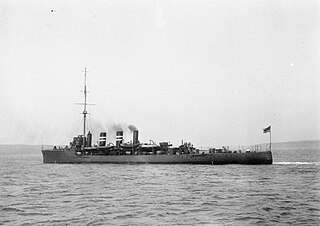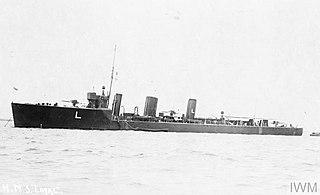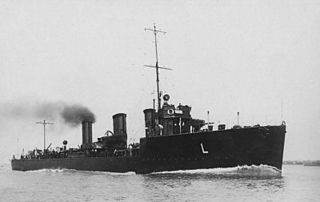
HMS Lance was a Laforey-class destroyer of the Royal Navy. Launched a few months before the outbreak of the First World War and attached to the Harwich Force, Lance took part in several engagements during the war, including the sinking of the Königin Luise and the Battle off Texel. She was responsible for firing the first British shot of the war.

HMS Amphion was an Active-class scout cruiser built for the Royal Navy before the First World War. Completed in 1913, she was initially assigned to the First Fleet and became a destroyer flotilla leader in mid-1914. When the war began, her flotilla was assigned to the Harwich Force. While patrolling on the first full day of the war, Amphion and her destroyers encountered and sank a German minelayer, SMS Königin Luise, but not before she had laid many of her mines. While returning from patrolling the following morning, Amphion struck a mine on 6 August 1914 off the Thames Estuary and sank with the loss of 132 crewmen killed. She was the first ship of the Royal Navy to be sunk in the First World War. The wreck site is protected and may not be dived upon without permission from the Ministry of Defence.

HMS Loyal was a Laforey-class destroyer built for the Royal Navy during the 1910s.

HMS Thisbe was an R-class destroyer which served in the Royal Navy during World War I. The R class were an improvement on the previous M class with geared steam turbines to improve efficiency. Built by Hawthorn Leslie and launched on 8 March 1917, the destroyer served as part of the Harwich Force. In 1918, the destroyer towed a flying boat on a lighter to take part in operations off the coast of Heligoland, although the aircraft failed to take off. After the war, the destroyer was placed in reserve, and participated in trials with the Compass Department in 1925. The ship was sold to be broken up on 31 August 1936.

HMS Landrail was a Laforey-class destroyer of the British Royal Navy. The Laforey class was the class of destroyers ordered under the Royal Navy's 1912–1913 construction programme, which were armed with three 4-inch (102 mm) guns and four torpedo tubes and were capable of 29 knots. The ship, which was originally to be named Hotspur but was renamed before launch, was built by the Scottish shipbuilder Yarrow between 1912 and 1914,
HMS Lark was a Laforey-class destroyer of the British Royal Navy. The Laforey class was the class of destroyers ordered under the Royal Navy's 1912–1913 construction programme, which were armed with three 4-inch (102 mm) guns and four torpedo tubes and were capable of 29 knots. The ship, which was originally to be named Haughty but was renamed before launch, was built by the Scottish shipbuilder Yarrow between 1912 and 1913.

HMS Springbok was an R-class destroyer which served with the Royal Navy during World War I. The R class were an improvement on the preceding M-class, including using geared steam turbines. Launched on 9 March 1917, the vessel operated as part of the Harwich Force on escort duties. In 1917, the destroyer, along with sister ship Thruster, captured the German merchant ships Brietzig and Pellworm. After the conflict, the destroyer initially was posted to the navy's torpedo school but was soon afterwards reduced to reserve. After less than ten years in service, Springbok was sold on 16 December 1926 and broken up.

HMS Laurel was a Laforey-class destroyer which served with the Royal Navy. Launched on 6 May 1913 as HMS Redgauntlet, the ship was renamed on 30 September under an Admiralty order to become one of the first alphabetical class destroyers. On commissioning, the vessel joined the 3rd Destroyer Flotilla and operated as part of the Harwich Force during the First World War. During Battle of Heligoland Bight, Laurel led a flotilla that pursued German torpedo boats, engaging with G194 and G196, and was damaged in action with the cruiser Mainz. The vessel also played a minor role in the Battles of Dogger Bank, Dover Strait and Jutland. With the cessation of hostilities, the ship was placed in reserve and scrapped on 1 November 1921.

HMS Liberty was a Laforey-class destroyer that served with the Royal Navy during the First World War. Launched on 15 September 1913 as HMS Rosalind, the ship was renamed on 30 September under an Admiralty order to become one of the first alphabetical class destroyers. On commissioning, the vessel joined the Third Destroyer Flotilla and operated as part of the Harwich Force. During Battle of Heligoland Bight, Liberty engaged with the German torpedo boats G194 and G196, and scored two hits on the cruiser Mainz. On 8 February 1917, the destroyer rammed and sank the German submarine UC-46. The vessel also played a minor role in the battles of Dogger Bank, Dover Strait and Jutland, as well as acting as a convoy escort and patrolling the Dover Barrage. With the cessation of hostilities, the ship was placed in reserve and sold to be broken up on 5 November 1921.

HMS Lysander was a Laforey-class destroyer that served with the Royal Navy during the First World War. Launched in August 1913 as HMS Ulysses, the ship was renamed the following month under an Admiralty order to become one of the first in what would be the norm, a class of destroyers named after successive letters of the alphabet. On commissioning, the vessel joined the Third Destroyer Flotilla and operated as part of the Harwich Force. The destroyer took part in the Battle of Heligoland Bight in 1914, attacking the German light cruiser Mainz and escorted the seaplane carriers Engadine and Riviera in an abortive attempt to attack the Cuxhaven airship base. During 1915, Lysander undertook anti-submarine patrols and escorting duties, coming under fire from German short-based batteries while accompanying the mine-laying paddle-steamers Prince of Wales and Queen Victoria off the coast of Ostend. In 1916, the destroyer was involved in action with German battlecruisers following the bombardment of Yarmouth and Lowestoft but escaped unharmed, and rescued the survivors from the Canadian hospital ship Llandovery Castle in 1918. With the cessation of hostilities, the ship was placed in reserve and sold to be broken up in June 1922.

HMS Redoubt was an R-class destroyer which served with the Royal Navy during World War I. The R class was an improvement of the preceding M-class, primarily through having geared steam turbines which offered greater efficiency and range. Launched on 28 October 1916, the ship joined the Harwich Force, operating as part of a destroyer flotilla undertaking convoy escort and anti-submarine operations in the North Sea. During 1918, Redoubt took part in an experiment to launch fighter aircraft from a lighter towed beyond a destroyer. The first flight took place on 1 August and the first successful operation ten days later when the Sopwith Camel flew by Lieutenant S.D. Culley took off and destroyed the German airship LZ 100. After the war, the vessel was transferred to the Home Fleet but was sold on 13 July 1926 to be broken up, part of a large scale disposal of older destroyers by the Navy.

HMS Llewellyn was a Laforey-class destroyer that served with the Royal Navy. Laid down on 14 December 1912 as HMS Picton, the ship was renamed on 30 September 1913 under an Admiralty order to become one of the first alphabetical class destroyers, being launched on 30 October. On commissioning, the vessel joined the Third Destroyer Flotilla and operated as part of the Harwich Force during the First World War. The destroyer took part in the Battle of Heligoland Bight, as well as undertaking anti-submarine patrols and escort duties. It was during one of these patrols on 4 December 1916 that the vessel unsuccessfully attacked the German submarine UB-18. On 17 March 1917, the destroyer was struck in the bow by a torpedo launched by a German torpedo boat while rescuing survivors from the sunk destroyer Paragon, but returned to port safely by steaming backwards. With the cessation of hostilities, the ship was placed in reserve. Although subsequently offered for sale to the Finnish Navy, Llewellyn was instead withdrawn from service and sold to be broken up on 18 March 1922.

HMS Lawford was a Laforey-class destroyer of the British Royal Navy. The Laforey class was the class of destroyers ordered under the Royal Navy's 1912–1913 construction programme, which were armed with three 4-inch (102 mm) guns and four torpedo tubes and were capable of 29 knots. The ship, which was originally to be named Ivanhoe but was renamed before launch, was built by the Scottish shipbuilder Fairfields between 1912 and 1914.

HMS Paladin was a Admiralty M-class destroyer which served with the Royal Navy during the First World War. The M class were an improvement on the previous L-class destroyer, capable of higher speed. Launched on 27 March 1916. Paladin took part in the Royal Navy sorties against German minesweepers in 1917, which culminated in the Second Battle of Heligoland Bight on 17 November, although the destroyer did not engage with any enemy warships during the battle. After the end of the war, the ship was placed in reserve before being decommissioned and sold to be broken up on 9 May 1921.

HMS Moorsom was an Admiralty M-class destroyer which served in the Royal Navy during the First World War. The M class was an improvement on the preceding L class, capable of higher speed. Moorsom, the first ship to enter navy service to be named after Admiral Sir Robert Moorsom, was launched in December 1914, initially serving as part of the Grand Fleet before being transferred to the Harwich Force the following year. Briefly rejoining the Grand Fleet, the destroyer saw service in the Battle of Jutland in 1916 supporting the British battlecruisers and received hits from a battleship of the German High Seas Fleet. Moorsom also undertook other duties, including escorting the troop ship Mauretania in June 1915 and the minelayer Princess Margaret in August 1915 and November 1916. Placed within the Dover Patrol, the destroyer formed part of the cover for monitors including Erebus and Terror on attacks on Ostend and Zeebrugge in May and June 1917, and April and May 1918. After the Armistice, the destroyer was placed in reserve and subsequently sold to be broken up in November 1921.

HMS Morris was an Admiralty M-class destroyer which served with the Royal Navy during the First World War. The M class were an improvement on the preceding L class, capable of higher speed. The ship, the only vessel to be named Morris to serve with the Royal Navy, was launched on 19 November 1914. Joining the Grand Fleet as part of a new flotilla, the destroyer was soon in action, serving as part of a destroyer screen during the Battle of Dogger Bank in January 1915 and an escort to the minelayer Princess Margaret during a skirmish with German torpedo boats eight months later. At the Battle of Jutland in 1916, the destroyer was a crucial part of the flotilla that drove the German torpedo boats away from the British battlecruisers. Morris received no hits during these confrontations. The destroyer assisted in the rescue of survivors from the R-class destroyer Simoom and the recovery of the damaged flotilla leader Botha in 1917. The ship also undertook general duties including escorting merchant ships, minelayers, monitors, and the seaplane carrier Vindex. After the armistice that ended the war, the destroyer was considered superfluous to requirements, Initially placed in reserve, Morris was decommissioned and, on 8 November 1921, sold to be broken up.

HMS Napier was a Repeat Admiralty M-class destroyer which served in the Royal Navy during the First World War. The M class were an improvement on the previous L-class destroyer, capable of higher speed. The vessel was launched on 27 November 1915 and joined the Grand Fleet. Napier had a varied war career, acting as part of the destroyer screen for the First Battle Squadron during the Second Battle of Heligoland Bight and searching for the survivors of losses like the armoured cruiser HMS Hampshire. The vessel was usually based at Scapa Flow but spent a brief time seconded to the Harwich Force in 1917. After the Armistice that marked the end of the First World War, Napier was placed in reserve before being decommissioned and sold to be broken up on 8 November 1921.

HMS Stork was an R-class destroyer that served in the Royal Navy during the First World War. The R-class were an improvement on the previous M-class with geared steam turbines to improve efficiency. Launched by Hawthorn Leslie at Hebburn in 1917, Stork joined the Harwich Force. The destroyer saw service escorting convoys in the English Channel and encountered both German submarines and torpedo boats, but did not record any hits on the enemy. The vessel also supported attacks on German forces on the coast of Western Europe by Coastal Motor Boats, flying boats and monitors, including the Zeebrugge Raid of 1918.

HMS Lookout was a Laforey-class destroyer that served with the Royal Navy during the First World War. Laid down in 1912 as HMS Dragon, the ship was renamed in 1913 under an Admiralty order to become one of the first alphabetical class destroyers. Launched in 1914, Lookout joined the Harwich Force and participated in the Battle of Heligoland Bight, attacking the German light cruiser Strassburg with torpedoes, and the Battle of Dogger Bank. For much of the war, the ship acted as an escort for a wide range of ships, including the troopships carrying soldiers to serve in the Gallipoli campaign and the seaplane carriers Riviera and Vindex during an attack on the Zeppelin hangers at Zeebrugge. From 1917, the destroyer served as an escort to convoys of merchant ships. At the end of the war, the warship was placed in reserve. Although subsequently offered for sale to the Finnish Navy, Lookout was instead withdrawn from service and sold to be broken up in 1922.

HMS Nonsuch was a Repeat Admiralty M-class destroyer that served in the Royal Navy during the First World War. The M class was an improvement on those of the preceding L class, capable of higher speed. Originally laid down as HMS Narcissus but renamed before being launched in 1915, Nonsuch joined the Twelfth Destroyer Flotilla of the Grand Fleet. During the Battle of Jutland in 1916, after being attacked by the light cruisers of the German High Seas Fleet, the warship rescued the damaged destroyer Acasta. The vessel formed part of the screen for the dreadnought battleships of the First Battle Squadron during the Second Battle of Heligoland Bight in 1917. In both actions, the destroyer reported no hits. After the Armistice that ended the war, Nonsuch was initially put in reserve and then sold in 1921 to be broken up.















